SAP Netweaver
ActiveBatch supports SAP Netweaver scheduling through an SAP-certified implementation of its scheduling interfaces (namely XP-BP V2.0,3.0 and BW-SCH 3.x). With the SAP job steps that follow you will be able to encapsulate existing SAP jobs within ActiveBatch jobs as well as enumerate many SAP objects directly within the ActiveBatch system.
A common property across all SAP job steps is the “Login” collection of properties. This class of properties handles the connection and security aspects of connecting to an SAP system. Rather than specify these properties for every SAP job step, the Best Practice approach is to deploy a “Login” job step in which the same properties can be inherited by each downstream SAP job step.
Several SAP job steps return a collection of objects. To iterate through the object collection, please use the ForEachItem job step.
ActiveBatch requires that NW SAP RFC SDK be installed on the Job Scheduler machine as well as any Execution Agents that are expected to run the SAP job steps.
When connecting to an SAP, a User Account object containing security access and credentials must be specified.

The connection string information include the host (ashost) the SAP server software resides on, the user (SAP username), and the client number. The password for the (client) user must also be provided.
The following parameters are required:
| ASHOST | This parameter refers to the FQDN of an SAP Application Server. This syntax is used if you are logging directly into this application server. |
| USER | This parameter is the SAP user account. |
| CLIENT | This parameter is the SAP Client ID to connect with. |
| SYSNR | This parameter is the SAP system id. |
| XBPVER | This parameter indicates the XBP (eXternal Background Processing) version of SAP you are using. For example, if you are using version 3.0, then set this parameter as follows: xbpver=3.0 |
| MSHOST | This parameter refers to the host name of the SAP Message Server. It is used when you are logging in to a logon group using load balancing |
| GROUP | This parameter refers to the group name of the application servers. It is used when you are logging in to a logon group using load balancing. |
| R3NAME | This parameter specifies the name of the SAP system. It is used when logging into a logon group using load balancing. |
The ASHOST parameter is mutually exclusive from the MSHOST, GROUP, and R3NAME parameters.
The syntax for specifying a parameter and value is “parameter=value”. Multiple parameters are delimited with a semicolon (;).
ABAP Step Helper
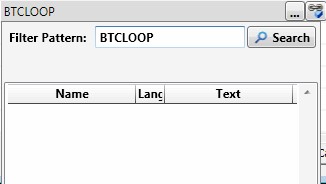
The Helper above is used for the ProgramName prompt to help retrieve matching ABAP step names.
The Netweaver Job Steps are listed below
This job step activates a profile. Profiles are used as part of Criteria Management. Job Interception, Event History, Event History Reorganization.

Job Step Properties
Profile – A profile key consists of two (2) properties:
-
Profile ID – A unique number assigned when the profile is created.
-
Profile Type – The type of profile. INTERC represents Job Interception, EVTHIS represents Event History and EVTHIRO represents Event History Reorganization. Other types can be user created and specified.
Login – This property is a User Account object that provides security credentialed access to an SAP system. If you have begun this job stream with a Login Job Step you can ignore this parameter.
This job step cancels an existing SAP Job.

Job Step Properties
Job – This property an existing SAP Job. The desired job can be retrieved through selection of the SAP Job Browser helper button (just to the right of the property). This property supports ActiveBatch variables.
Login – This property is a User Account object that provides security credentialed access to an SAP system. If you have begun this job stream with a Login Job Step you can ignore this parameter.
This job step allows you to change a Variant. A Variant is a pre-defined set of parameters that can be associated with a Program.
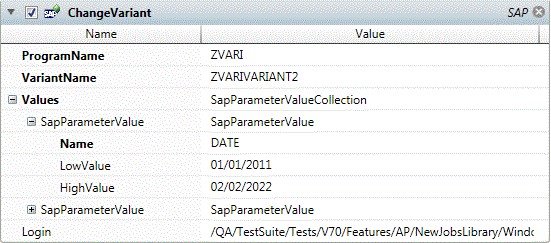
Job Step Properties
ProgramName – This property is the Program Name. The helper allows you to lookup existing Program Names.
VariantName – This dropdown displays the existing variants.
Values – Zero or more parameters that form a collection of parameter values to be used for the Report Variant.
Login – This property is a User Account object that provides security credentialed access to an SAP system. If you have begun this job stream with a Login Job Step you can ignore this parameter.
This job step allows you to copy an existing SAP job to a new job.

Job Step Properties
Job – This property represents the name of an existing SAP job.
StartCondition – This property represents the starting condition of the new job. None, Immediate, ASAP and Event are possible selections.
Login – This property is a User Account object that provides security credentialed access to an SAP system. If you have begun this job stream with a Login Job Step you can ignore this parameter.
TargetJobName – This property represents the name of the new SAP Job.
This job step allows you to copy an existing Variant.

Job Step Properties
ProgramName – This property is the Program Name. The helper allows you to lookup existing Program Names.
SourceVariant – This dropdown provides a list of existing variants for selection. Please select one as the source.
TargetVariant – This property is the name of the destination or target variant. The name must be unique and obey SAP naming standards.
Login – This property is a User Account object that provides security credentialed access to an SAP system. If you have begun this job stream with a Login Job Step you can ignore this parameter.
This job step allows you to create a new SAP Job.
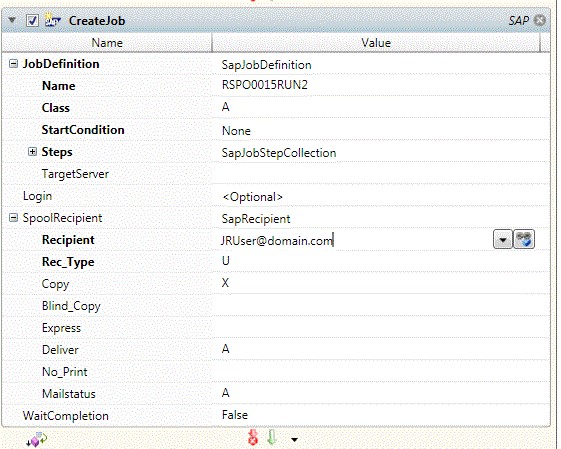
Job Step Properties
-
JobDefinition – This is a collection of properties that defines the name of the job and the various steps this job is comprised of.
-
Name – This property is the name of the SAP job.
-
Class – This property is the class of the SAP job. For example A, B or C.
-
StartCondition – This property represents the starting condition of the job. Selections are: None, Immediate, ASAP and Event.
-
Steps – This is a collection of properties that defines one or more steps that make up this SAP job. A step can be an “ABAP step” or an “External Program step”. ProgramName is the same of the program to be executed. TargetHost is the hostname that is the target of the executing program. UserName is the Netweaver user for this step (Note: Case sensitive). TargetServer is the AS ABAP instance name (can be omitted if only instance present). ExtProgramParameters are zero or more parameters that are passed to the specified program. WaitForTermination is a Boolean property that indicates whether we should wait for the step to complete before continuing.
Login – This property is a User Account object that provides security credentialed access to an SAP system. If you have begun this job stream with a Login Job Step you can ignore this parameter.
SpoolRecipient – This collection of properties controls the list of recipients for spooled reports.
WaitCompletion – This Boolean property indicates whether ActiveBatch should wait for the SAP job to complete.
Return Step Value
This step returns the name and number of the newly created SAP job.
This job step allows you to create a Profile.

Job Step Properties
Criteria Profile – This property represents a file specification that contains an XML specification for the profile.
Login – This property is a User Account object that provides security credentialed access to an SAP system. If you have begun this job stream with a Login Job Step you can ignore this parameter.
This job step allows you to create a variant.

Job Step Properties
ProgramName – This property is the Program Name. The helper allows you to lookup existing Program Names.
VariantName – This property represents the name of the new variant.
Login – This property is a User Account object that provides security credentialed access to an SAP system. If you have begun this job stream with a Login Job Step you can ignore this parameter.
VariantText – This property is the simple description of the variant.
This job step deactivates a profile that was previously set.

Job Step Properties
Profile – A profile key consists of two (2) properties:
-
Profile ID – A unique number assigned when the profile is created.
-
Profile Type – The type of profile. INTERC represents Job Interception, EVTHIS represents Event History and EVTHIRO represents Event History Reorganization. Other types can be user created and specified.
Login – This property is a User Account object that provides security credentialed access to an SAP system. If you have begun this job stream with a Login Job Step you can ignore this parameter.
This job step allows you to delete an existing SAP Job.

Job Step Properties
Job – This property represents the name of an existing SAP job that will be deleted.
Login – This property is a User Account object that provides security credentialed access to an SAP system. If you have begun this job stream with a Login Job Step you can ignore this parameter.
This job step deletes a previously existing profile.

Job Step Properties
Profile – A profile key consists of two (2) properties:
-
Profile ID – A unique number assigned when the profile is created.
-
Profile Type – The type of profile. INTERC represents Job Interception, EVTHIS represents Event History and EVTHIRO represents Event History Reorganization. Other types can be user created and specified.
Login – This property is a User Account object that provides security credentialed access to an SAP system. If you have begun this job stream with a Login Job Step you can ignore this parameter.
This job step deletes a previously existing variant.

Job Step Properties
ProgramName – This property is the Program Name. The helper allows you to lookup existing Program Names.
VariantName – This dropdown contains the existing variants associated with this Program. You may also enter a variable or the actual variant name.
Login – This property is a User Account object that provides security credentialed access to an SAP system. If you have begun this job stream with a Login Job Step you can ignore this parameter.
This job step displays an existing InfoPackage.

Job Step Properties
Request Id – This property is the ID of the InfoPackage.
Login – This property is a User Account object that provides security credentialed access to an SAP system. If you have begun this job stream with a Login Job Step you can ignore this parameter.
This job step displays an existing Process Chain(s).

Job Step Properties
ProcessChain – This dropdown allows you to specify the name of the Process Chain. You may specify a variable or the actual name of the Process Chain.
Login – This property is a User Account object that provides security credentialed access to an SAP system. If you have begun this job stream with a Login Job Step you can ignore this parameter.
Log ID – This optional property represents the Log ID. If omitted, basic or summary information is presented. If an ID is presented, full information about the Process Chain is displayed.
This job step displays existing profiles.

Job Step Properties
Profile Type – This dropdown allows you to select which profiles to display. Types are: All which displays all profile types and specific types of EventHistory, RaisedEventsReorganization and Interception.
Login – This property is a User Account object that provides security credentialed access to an SAP system. If you have begun this job stream with a Login Job Step you can ignore this parameter.
Profile ID – This optional property allows you specify a numeric profile ID for the specific profile you wish to display.
This job step allows you to retrieve the job status of a “child”.
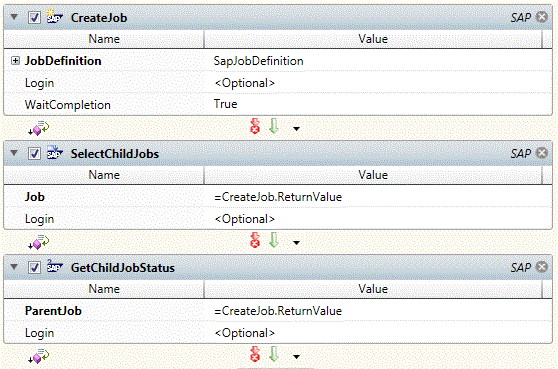
Job Step Properties
ParentJob – This property represents the name of an existing parent job. The parent job issued a ZMAKECHILD ABAP step. Note the use of the =CreateJob.ReturnValue. The return value of the Create Job step can be used to select any child jobs created by the parent and then this job step, GetChildJobStatus, retrieves the status.
Login – This property is a User Account object that provides security credentialed access to an SAP system. If you have begun this job stream with a Login Job Step you can ignore this parameter.
Return Step Value
This step returns a SAPJobInfoCollection object representing the children job status.
This job step retrieves the SAP Job’s application logfile.

Job Step Properties
Job – This property represents the Job Key (which is the name and number of the job).
Login – This property is a User Account object that provides security credentialed access to an SAP system. If you have begun this job stream with a Login Job Step you can ignore this parameter.
This job step allows you to retrieve a job’s status.

Job Step Properties
Job – This property represents the name of an existing SAP job.
Login – This property is a User Account object that provides security credentialed access to an SAP system. If you have begun this job stream with a Login Job Step you can ignore this parameter.
This job step allows you to retrieve a Spool List (or the spooled output of the job).

Job Step Properties
Job – This property represents the Job Key (which is the name and number of the job).
SpoolRequest – This numeric property indicates the number of the spooled request. Zero (0) indicates that all spooled requests are to be retrieved; 1 means that the first spooled request is to be retrieved; etc.
Login – This property is a User Account object that provides security credentialed access to an SAP system. If you have begun this job stream with a Login Job Step you can ignore this parameter.
This job step allows you to initiate a login to an SAP system. Every SAP job step requires that you be logged in. This job step satisfies that requirement when placed at the beginning of a SAP job stream.

Job Step Properties
Login – This property is a User Account object that provides security credentialed access to an SAP system.
The ActiveBatch Reference Manual contains more information on the creation of an SAP Connection string for the User Account object (see “User Account Object – SAP Connection” for more details). This object is used to create the connection and then provide authentication information to SAP.
This job step modifies the SAP Job Interception table.
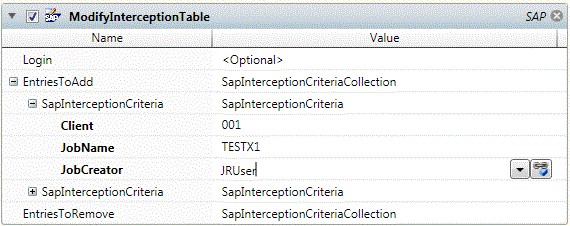
Job Step Properties
Login – This property is a User Account object that provides security credentialed access to an SAP system. If you have begun this job stream with a Login Job Step you can ignore this parameter.
EntriesToAdd. This collection of properties contains entries that create SAP job interception. Interception criteria include Client, JobName and JobCreator properties.
EntriesToRemove. This collection of properties contains entries that remove existing SAP job interception.
This job step allows you to raise an event.

Job Step Properties
EventID – This dropdown allows you to specify an event.
Login – This property is a User Account object that provides security credentialed access to an SAP system. If you have begun this job stream with a Login Job Step you can ignore this parameter.
EventParameter – This property is a parameter that is associated with the raised event.
This job step allows you to read a specified SAP job log.

Job Step Properties
Job – This property represents the name of an existing SAP job.
Login – This property is a User Account object that provides security credentialed access to an SAP system. If you have begun this job stream with a Login Job Step you can ignore this parameter.
Write to ActiveBatch Log – This Boolean property indicates whether the information in the SAP job log should be appended to your ActiveBatch job log file. If true, the information is appended. If false, the information is only returned as part of the job step.
Return Step Value
This step returns the SAP job log information.
This job step removes a Process Chain.

Job Step Properties
ProcessChain – This dropdown allows you to specify the name of the Process Chain. You may specify a variable or the actual name of the Process Chain.
Login – This property is a User Account object that provides security credentialed access to an SAP system. If you have begun this job stream with a Login Job Step you can ignore this parameter.
This job step restarts a Process Chain that is broken.

Job Step Properties
Process Chain - This dropdown allows you to specify the name of the Process Chain. You may specify a variable or the actual name of the Process Chain.
Log ID – This optional property represents the Log ID.
Login – This property is a User Account object that provides security credentialed access to an SAP system. If you have begun this job stream with a Login Job Step you can ignore this parameter.
This job step allows you to select a parent’s child jobs.

Job Step Properties
Job – This property represents the name of an existing SAP job.
Login – This property is a User Account object that provides security credentialed access to an SAP system. If you have begun this job stream with a Login Job Step you can ignore this parameter.
Return Step Value
This step returns a collection of SAP child job instances.
This job step allows you to select one or more jobs based on a search (filter) criteria.
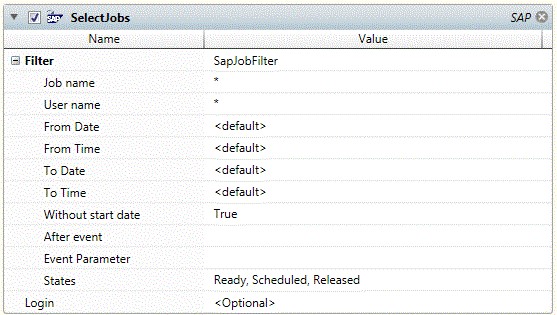
Job Step Properties
Filter – This collection of properties represents search (filter) criteria that can be used to select jobs.
Login – This property is a User Account object that provides security credentialed access to an SAP system. If you have begun this job stream with a Login Job Step you can ignore this parameter.
Return Step Value
This step returns a collection of SAP job instances.
This job step allows you to select intercepted jobs.

Job Step Properties
Login – This property is a User Account object that provides security credentialed access to an SAP system. If you have begun this job stream with a Login Job Step you can ignore this parameter.
Client – This property represents the Client ID.
This job step sets the SAP Job Interception Table.

Job Step Properties
Login – This property is a User Account object that provides security credentialed access to an SAP system. If you have begun this job stream with a Login Job Step you can ignore this parameter.
Client – This property represents the Client ID.
This job step modifies an existing profile.

Job Step Properties
Profile – A profile key consists of two (2) properties:
-
Profile ID – A unique number assigned when the profile is created.
-
Profile Type – The type of profile. INTERC represents Job Interception, EVTHIS represents Event History and EVTHIRO represents Event History Reorganization. Other types can be user created and specified.
Criteria Profile – This property represents a file specification that contains an XML specification for the profile.
Login – This property is a User Account object that provides security credentialed access to an SAP system. If you have begun this job stream with a Login Job Step you can ignore this parameter.
This job step starts an Info Package.

Job Step Properties
InfoPackage – This dropdown, using the specified Selection Information, consists of InfoPackage(s) that meet your selection criteria. Select one InfoPackage from the dropdown or specify the specific InfoPackage.
Login – This property is a User Account object that provides security credentialed access to an SAP system. If you have begun this job stream with a Login Job Step you can ignore this parameter.
JobName – This property is the name of this job.
WaitForCompletion – This Boolean property indicates whether to wait for the InfoPackage to complete.
WaitInterval – This numeric property indicates the polling interval to check for job completion.
This job step starts a Process Chain.
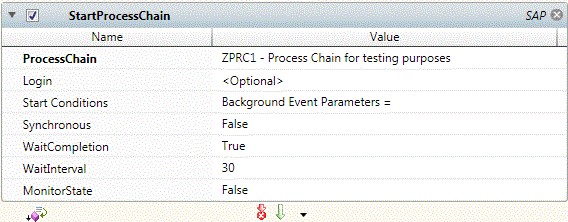
Job Step Properties
Process Chain - This dropdown allows you to specify the name of the Process Chain. You may specify a variable or the actual name of the Process Chain.
Login – This property is a User Account object that provides security credentialed access to an SAP system. If you have begun this job stream with a Login Job Step you can ignore this parameter.
Start Conditions – This dropdown indicates the various start conditions for this Process Chain.
Synchronous – This Boolean property indicates whether the Process Chain itself should be executed in a synchronous or asynchronous manner.
WaitCompletion – This Boolean property indicates whether the job step should wait for the completion of the Process Chain.
WaitInterval – This numeric property indicates the polling interval to check for job completion.
MonitorState – This Boolean property indicates whether the intermediate results of the Process Chain job should be captured as part of the ActiveBatch job log.
This job step allows you to start an existing SAP job.

Job Step Properties
Job – This property represents the name of an existing SAP job.
Login – This property is a User Account object that provides security credentialed access to an SAP system. If you have begun this job stream with a Login Job Step you can ignore this parameter.
StartOption –This dropdown property is either ASAP or Immediate.
WaitCompletion – This Boolean property indicates whether ActiveBatch should wait for the SAP job to complete.
TargetServer – This property represents a Netweaver hostname instance.
This job step allows you to synchronize with an already executing job.

Job Step Properties
Job – This property represents the name of an existing SAP job.
Login – This property is a User Account object that provides security credentialed access to an SAP system. If you have begun this job stream with a Login Job Step you can ignore this parameter.
UseOriginalJobStatus – This Boolean property allows you to set the synchronized job’s status to this job step. If true, the original job status determines if this step succeeds or fails.
Return Step Value
This step returns the status of the synchronized job’s status.
This job synchronizes an already started InfoPackage.

Job Step Properties
Request Id – This property is the ID of the InfoPackage.
Login – This property is a User Account object that provides security credentialed access to an SAP system. If you have begun this job stream with a Login Job Step you can ignore this parameter.
WaitInterval – This numeric property indicates the polling interval to check for job completion.
This job step synchronizes an already started Process Chain.

Job Step Properties
Process Chain - This dropdown allows you to specify the name of the Process Chain. You may specify a variable or the actual name of the Process Chain.
Log ID – This optional property represents the Log ID.
Login – This property is a User Account object that provides security credentialed access to an SAP system. If you have begun this job stream with a Login Job Step you can ignore this parameter.
WaitInterval – This numeric property indicates the polling interval to check for job completion.
MonitorState – This Boolean property indicates whether the intermediate results of the Process Chain job should be captured as part of the ActiveBatch job log.